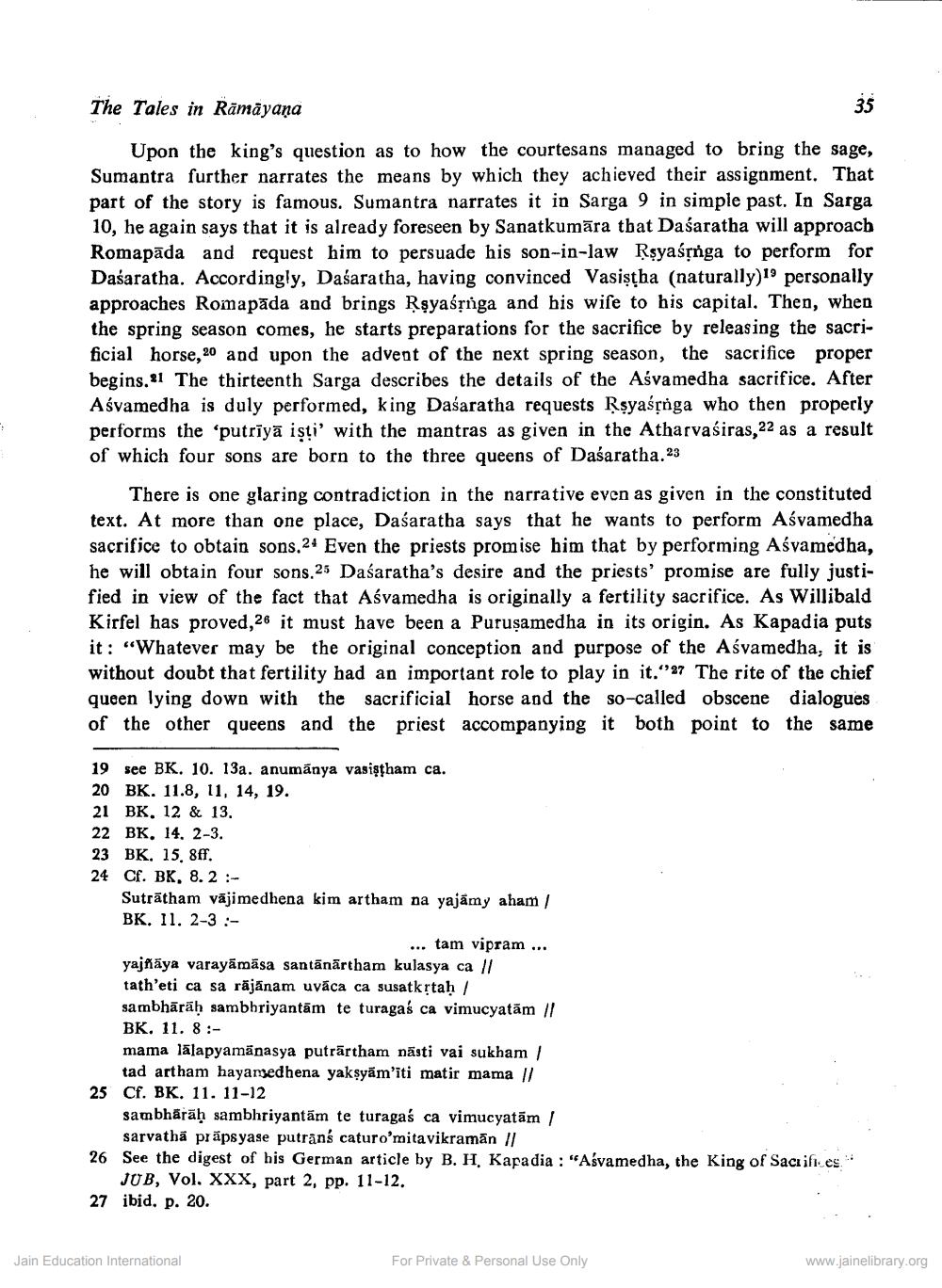________________
The Tales in Rāmāyaņa
35
Upon the king's question as to how the courtesans managed to bring the sage, Sumantra further narrates the means by which they achieved their assignment. That part of the story is famous. Sumantra narrates it in Sarga 9 in simple past. In Sarga 10, he again says that it is already foreseen by Sanatkumāra that Dasaratha will approach Romapāda and request him to persuade his son-in-law Rşyaśộnga to perform for Daśaratha. Accordingly, Dasaratha, having convinced Vasiştha (naturally)"' personally approaches Romapāda and brings Rşyaśộnga and his wife to his capital. Then, when the spring season comes, he starts preparations for the sacrifice by releasing the sacrificial horse, 20 and upon the advent of the next spring season, the sacrifice proper begins.81 The thirteenth Sarga describes the details of the Aśvamedha sacrifice. After Aśvamedha is duly performed, king Dasaratha requests Rsyaśộnga who then properly performs the 'putrīyā işti' with the mantras as given in the Atharvasiras, 22 as a result of which four sons are born to the three queens of Daśaratha.23
There is one glaring contradiction in the narrative even as given in the constituted text. At more than one place, Dasaratha says that he wants to perform Aśvamedha sacrifice to obtain sons.24 Even the priests promise him that by performing Aśvamedha, he will obtain four sons.25 Dasaratha's desire and the priests' promise are fully justified in view of the fact that Aśvamedha is originally a fertility sacrifice. As Willibald Kirfel has proved,26 it must have been a Purusamedha in its origin. As Kapadia puts it: “Whatever may be the original conception and purpose of the Aśvamedha, it is without doubt that fertility had an important role to play in it."97 The rite of the chief queen lying down with the sacrificial horse and the so-called obscene dialogues of the other queens and the priest accompanying it both point to the same
19 see BK. 10. 13a. anumānya vasiştham ca. 20 BK. 11.8, 11, 14, 19. 21 BK, 12 & 13. 22 BK, 14, 2-3. 23 BK. 15. 8ff. 24 Cf. BK, 8.2 :
Sutrātham vājimedhena kim artham na yajámy aham/ BK. Il. 2-3 :
... tam vipram ... yajñāya varayāmāsa santānārtham kulasya ca // tath'eti ca sa rājānam uvāca ca susatkrtah / sambhārah sambhriyantām te turagaś ca vimucyatām // BK, 11. 8:mama lālapyamänasya putrārtham nästi vai sukham
tad artham hayamsedhena yaksyām'iti matir mama // 25 Cf. BK. 11. 11-12
sambhäräḥ sambhriyantām te turagaś ca vimucyatām
sarvathä präpsyase putrans caturo'mitavikramän Il 26 See the digest of his German article by B. H. Kapadia : "Aśvamedha, the King of Sacrifices **
JUB, Vol. XXX, part 2, pp. 11-12. 27 ibid. p. 20.
Jain Education International
For Private & Personal Use Only
www.jainelibrary.org




